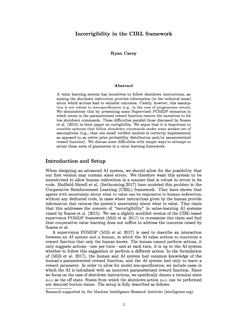MIRI assistant research fellow Ryan Carey has a new paper out discussing situations where good performance in Cooperative Inverse Reinforcement Learning (CIRL) tasks fails to imply that software agents will assist or cooperate with programmers.
The paper, titled “Incorrigibility in the CIRL Framework,” lays out four scenarios in which CIRL violates the four conditions for corrigibility defined in Soares et al. (2015). Abstract:
A value learning system has incentives to follow shutdown instructions, assuming the shutdown instruction provides information (in the technical sense) about which actions lead to valuable outcomes. However, this assumption is not robust to model mis-specification (e.g., in the case of programmer errors). We demonstrate this by presenting some Supervised POMDP scenarios in which errors in the parameterized reward function remove the incentive to follow shutdown commands. These difficulties parallel those discussed by Soares et al. (2015) in their paper on corrigibility.
We argue that it is important to consider systems that follow shutdown commands under some weaker set of assumptions (e.g., that one small verified module is correctly implemented; as opposed to an entire prior probability distribution and/or parameterized reward function). We discuss some difficulties with simple ways to attempt to attain these sorts of guarantees in a value learning framework.
The paper is a response to a paper by Hadfield-Menell, Dragan, Abbeel, and Russell, “The Off-Switch Game.” Hadfield-Menell et al. show that an AI system will be more responsive to human inputs when it is uncertain about its reward function and thinks that its human operator has more information about this reward function. Carey shows that the CIRL framework can be used to formalize the problem of corrigibility, and that the known assurances for CIRL systems, given in “The Off-Switch Game”, rely on strong assumptions about having an error-free CIRL system. With less idealized assumptions, a value learning agent may have beliefs that cause it to evade redirection from the human.
[T]he purpose of a shutdown button is to shut the AI system down in the event that all other assurances failed, e.g., in the event that the AI system is ignoring (for one reason or another) the instructions of the operators. If the designers of [the AI system] R have programmed the system so perfectly that the prior and [reward function] R are completely free of bugs, then the theorems of Hadfield-Menell et al. (2017) do apply. In practice, this means that in order to be corrigible, it would be necessary to have an AI system that was uncertain about all things that could possibly matter. The problem is that performing Bayesian reasoning over all possible worlds and all possible value functions is quite intractable. Realistically, humans will likely have to use a large number of heuristics and approximations in order to implement the system’s belief system and updating rules. […]
Soares et al. (2015) seem to want a shutdown button that works as a mechanism of last resort, to shut an AI system down in cases where it has observed and refused a programmer suggestion (and the programmers believe that the system is malfunctioning). Clearly, some part of the system must be working correctly in order for us to expect the shutdown button to work at all. However, it seems undesirable for the working of the button to depend on there being zero critical errors in the specification of the system’s prior, the specification of the reward function, the way it categorizes different types of actions, and so on. Instead, it is desirable to develop a shutdown module that is small and simple, with code that could ideally be rigorously verified, and which ideally works to shut the system down even in the event of large programmer errors in the specification of the rest of the system.
In order to do this in a value learning framework, we require a value learning system that (i) is capable of having its actions overridden by a small verified module that watches for shutdown commands; (ii) has no incentive to remove, damage, or ignore the shutdown module; and (iii) has some small incentive to keep its shutdown module around; even under a broad range of cases where R, the prior, the set of available actions, etc. are misspecified.
Even if the utility function is learned, there is still a need for additional lines of defense against unintended failures. The hope is that this can be achieved by modularizing the AI system. For that purpose, we would need a model of an agent that will behave corrigibly in a way that is robust to misspecification of other system components.
[technical_papers_subscription_form]
